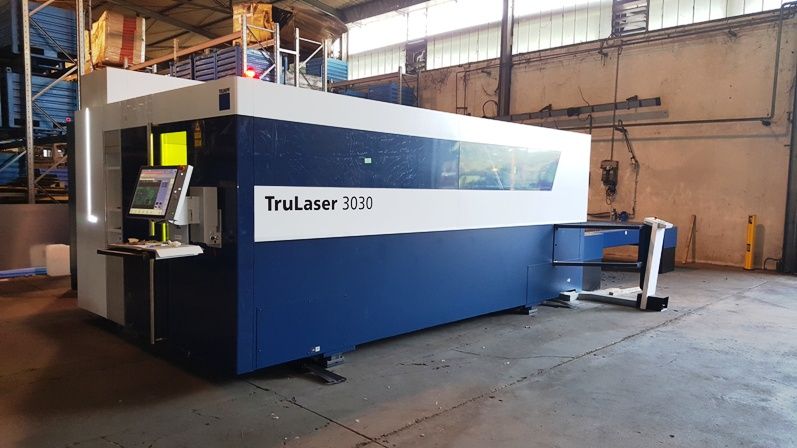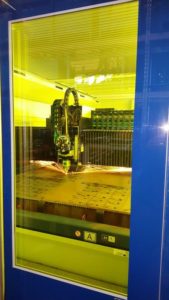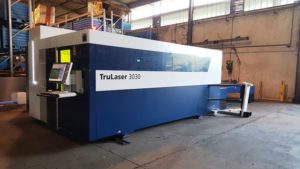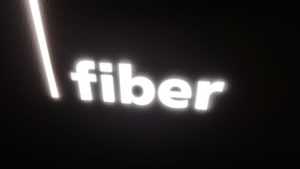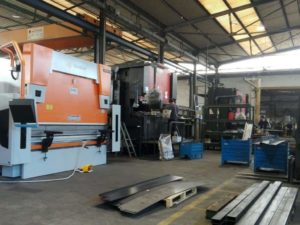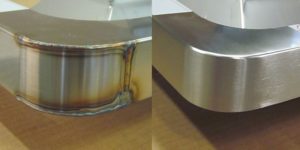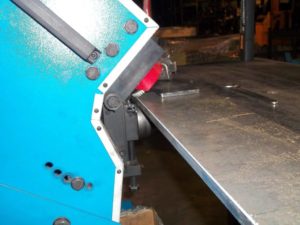Introduction for sheet metal laser
We use sheet metal laser cutting to process construction steel, stainless steel and aluminum alloys. Thanks to the laser beam mixed with a cutting gas that can be oxygen or nitrogen, the sheets are shaped starting from a flat sheet. When cutting iron, the use of nitrogen is preferable even if it is more expensive. In fact, oxygen tends to oxidize the edge, making it difficult for the paint to adhere to the edge. For stainless steel and aluminum alloys, only nitrogen can be used.
Laser is a thermal cut, like oxy-fuel or plasma, so the heating of the material must be taken into account. Sometimes this overheating can limit the cutting quality.
The process begins with a drawing that often occurs by importing the file created with a three-dimensional CAD. This drawing is “prepared” for cutting using the machine software by associating parameters. Then the machine replicates the shape of the drawing on the sheet metal.
If the piece needs to be bent after cutting, the development of the piece must be calculated, i.e. the folds must be opened. To calculate the correct shape with the relative springbacks of the materials, specific functions in the machine software are used.
.
Other possible types of cutting
There are alternatives to sheet metal laser cutting, non-thermal cuts. For example, water cutting is not a thermal cut and for this reason it can also cut other types of materials or greater thicknesses, but at the expense of speed. In fact, waterjet, as water cutting is called, has a much slower feed rate. Waterjet can therefore cut marble, stone, wood and plastics in general. It can also cut steels well over 30mm thick.
Finally, laser cutting machines in some specific situations can cut with compressed air. This is also a non-thermal cutting solution.
.
Our sheet metal laser cutting machines
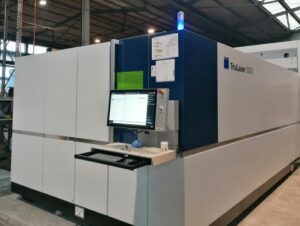 We currently have two sheet metal laser cutting systems and we also have two systems dedicated to tube processing.
We currently have two sheet metal laser cutting systems and we also have two systems dedicated to tube processing.
The most recent sheet metal cutting machine has a 3 kw fiber resonator, a 3 x 1.5 meter work area and is equipped with automatic loading and unloading. It is capable of cutting construction steel, stainless steel and aluminum alloys. This new sheet metal laser cutting machine also interacts with the factory management software. In addition, the system has software for diagnostics and predictive maintenance, limiting the risk of machine downtime.
The automatic loading and unloading system allows for reducing downtime in the processing cycle. In addition, it provides a certain autonomy to the system, which can therefore work in an unattended cycle.
Thanks to the arrival of the second machine, we have significantly increased the capacity for our cutting department. But not only because we have also improved the quality. In fact, by adding it to the other system (with a Co2 resonator) we can choose which technology to apply to maximize the benefits of each technology for our customers.
.
Our other machines
Thanks a bigger sheet metal laser cutting we work with sheets of up to 4 x 2 meters. Mainly we cut construction steel (S420MC, S500MC, S700MC, S355, S235) and stainless steels (Aisi304, Aisi316). We can work thicknesses up to 25mm for structural steel and 12mm for stainless steel.
Together with the arrival of the machine, we also installed a fourth press brake to organically strengthen the entire department.
.
Differences between Fiber and CO2 Laser Resonator 
In a carbon dioxide (CO2) machine, the laser beam is formed by high-frequency electromagnetic waves. These waves irradiated in a mixture of carbon dioxide, helium and nitrogen cause the carbon dioxide molecules to release photons that, when appropriately directed, form the laser beam.
While in a fiber machine, the laser (also called a solid-state laser) is generated by diodes. These are optically excited and by hitting rare earth crystals (typically ytterbium), the laser beam is obtained. Technically, it is said that the optical fiber is doped with these crystals. This results in a more stable and concentrated beam than the carbon dioxide one, as we will see shortly.
.
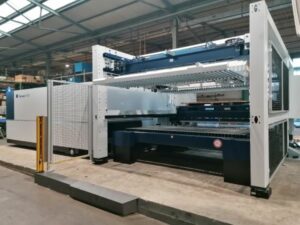
Cutoff limits for a fiber and CO2 resonator
As we mentioned before, there are substantial differences in metal processing based on the type of resonator. In fact, with fiber technology it is possible to make holes with a diameter much smaller than the thickness of the material. It can reach a ratio of 0.7 diameter to thickness. This is an insurmountable limit for CO2 resonators where we must stop at a ratio of 1; that is, the minimum hole diameter will be equal to the thickness of the sheet metal. It’s happen thanks to the size of the laser beam which is about 90% smaller than the laser beam generated by a CO2 source. This technical leap was made possible by the generation technique but also by the transmission of the beam. Fiber optics guarantee greater effectiveness than reflective mirrors.
On the other hand, starting from medium thicknesses, about 10mm, the cutting quality and speed of a CO2 resonator still has advantages. It is likely, however, that in the future the technique will develop in favor of the fiber source, a less energy-intensive technology, thus closing the technological gap in its favor even for thicknesses greater than 10mm.
Agrital
We are a metalworking company active since 1972 in Italy, near Milan. We are dedicated to sheet metal laser cutting for third parties for small and medium batches.
The company has started in the agricultural mechanization sector with the construction of tractor cabins.
Today, thanks to a staff of over 50 people, we are present in various product sectors, mainly producing driver’s cabins, hydraulic tanks and hoods. In addition to having been the forerunners since 2003 in laser tube processing.


